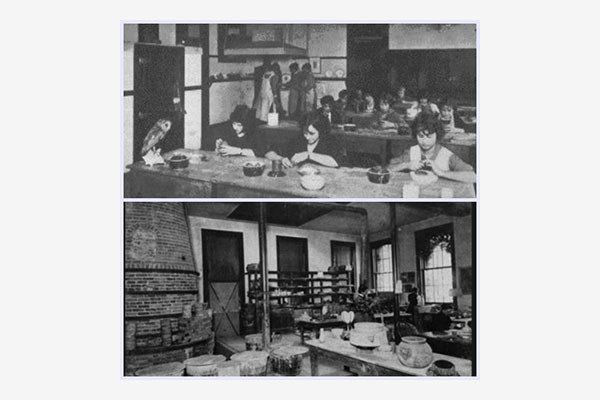Most people equate American art pottery with those names from Ohio – Roseville Pottery, Rookwood Pottery, Weller, Owens, Zanesville Stoneware and even McCoy. When you think of southern influences, it’s likely the first, and perhaps only, pottery maker that comes to mind is Newcomb Pottery, created at Newcomb College in New Orleans. But there’s far more to be loved and appreciated from artists of the south. Some say you can smell the salt air in each piece as much of it was made along the Gulf Coast, including both Newcomb Pottery and, of course, those incredible, though eclectic, creations that bore George Ohr’s mark.
Nashville Art Pottery created an avenue or stage for students in the Nashville School of Art. Headed by Bettie J. Scovel, who’d
been trained by some of the best of the best Rookwood artists, she returned to her Nashville roots in order to share her love of clay and the magic that comes when an artist’s hands shape the clay into something spectacular. It was the late 1880s and upon her return, she quickly secured what was then known as the McGavock building and set out to bring the artists alive inside her students. Before the decade was up, there would be two lines of Nashville Art Pottery released, including Goldstone and Pomegranate. Both were high fired wares, though Goldstone was notably darker with rich browns and deep red hues while its counterpart, Pomegranate, included lighter colors, including a typical white base with pink and blue elements. Unfortunately, Nashville Pottery didn’t become as well-known as those in Ohio, but the fruits of hers and her students’ hard work can be found in Trumbull Prime Collection of The Art Museum at Princeton University.
Around this same time, George Ohr, the famous Biloxi, Mississippi artist, and Joseph Meyer (yes, that Joseph Meyer) decided to fill a void left by the bankrupt Louisiana Porcelain Works in New Orleans. They created New Orleans Art Pottery. The building they chose was an impressive three stories. Soon, the two artists secured the necessary kiln and began producing, for a very brief time, their version of porcelain ware. Unfortunately, there wasn’t room enough for New Orleans Pottery and the exciting new Newcomb Pottery, so its contribution was quite limited. Before long, Meyer would find his way to Newcomb Pottery, where he left his life’s work for many future generations to admire.
From Ohr to Meyer to Scovel – and many more, the south was the birthplace for beautiful American art pottery designs.



